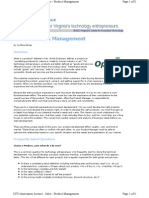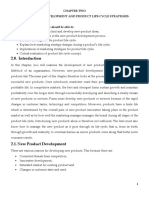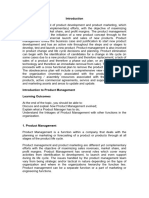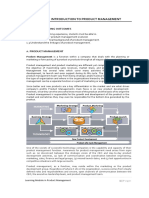New Product Development For Small Companies
New Product Development For Small Companies
Uploaded by
Madhuri KetaCopyright:
Available Formats
New Product Development For Small Companies
New Product Development For Small Companies
Uploaded by
Madhuri KetaOriginal Title
Copyright
Available Formats
Share this document
Did you find this document useful?
Is this content inappropriate?
Copyright:
Available Formats
New Product Development For Small Companies
New Product Development For Small Companies
Uploaded by
Madhuri KetaCopyright:
Available Formats
NEW PRODUCT DEVELOPMENT FOR SMALL COMPANIES
As business experts, analysts, executives, and entrepreneurs all know, there is no one way to organize a company for effective new product development. As Gruenwald noted, the ultimate methodology that is chosen "depends on the nature of the corporation and its goals. It depends on the existing structural order of things. It depends on the corporation's management style. It depends on the caliber, motivations, and growth potential of the staff in place at the time of installing the new products organization. It depends on past performance by organizations charged with the responsibility. It depends on the orientation of the corporation, if this is not to change. (Are the present strengths or weaknesses centered in certain areas?)." Nonetheless, analysts point to several factors that are fairly universal in determining whether a business will enjoy measurable success in new product development efforts. These include fundamentals like comprehensive market and cost analysis, support from top management, enthusiasm among workers, clear lines of authority, and past experience. Other qualities cited by marketing expert Kim Clark in Industry Week included focus, adequate resources, and leadership: Focus . First, a small business needs to focus on its goals. Limited time and resources mean that hard decisions must be made and a strategic plan needs to be developed. Companies should "do the right things right" by using the best information available to choose the right technologies and decide on what new products to invest in. Small companies are often growing quickly and can pick and choose among many seemingly strong new product avenues, but the key is to decide what the company does very well and then concentrate on that area or areas. Selecting the right focus can be a balancing act, however. A company needs to keep both short-term and long-term success in sight and needs to weigh rapid cash generation versus growth, business life cycles, and technology and market capabilities. All of these factors must come into play, and the risks associated with each must always be considered.
Clark notes that one way a company can stay focused is to develop a "product-line architecture." Once a company creates its overall strategy and determines how it will reach its goal, it should map out exactly what product lines it will choose to achieve that goal. "Product-line architecture tells you how your product line will look, what types of products you will have in what markets, how they will be positioned, and in what sequence they will be introduced." Defining a product-line architecture demands that correct decisions be made early in the product development process. Companies should be rigorous and quantitative when coming up with new product specifications or definitions. They should, as much as is possible, precisely define the product qualities and price points that a market will bear. Mistakes made early in the process will often not show up until it is far too lateeither at the prototype or final product stage. Customer feedback is essential at this stage and can eliminate mistakes in focus. As one executive told Industry Week , companies should ask themselves a series of questions when creating a new product-line vision: "How would someone use this product? How would you articulate the benefit to the customer? Is this something a customer can really understand [as to] how it makes their life easier?" Find the Resources . Another key to new product development for small businesses is to secure the resources and skills needed to create and market the new product. Small companies may lack the in-house resources needed to create a new product, making it seem out of reach, but analysts note that small business owners have other avenues that they can often pursue. If the product idea is good enough, the company may decide to look outside its own walls for partnership and outsourcing opportunities. "When the need is not within the capability of your company," states Gruenwald, "but beneficial arrangements can be made with other companies to joint-venture, contract-supply, license/acquire, or, in rare instances, to merge. Pools of expertise can also be acquired byrecruiting within the subject industry and by the use of technical and marketing consultants." One key to resource management is to not undertake too many projects at one time. Every company has a finite amount of resources to allocate to new product
development, but small businesses often face especially tight budgets in this regard. And budget in this instance doesn't just mean moneyit also means time. Too many projects means otherwise talented workers can't spend enough time on any one project, and as a result, all projects suffer and fall off schedule, leaving gaping openings for competitors or causing market windows to close. Leadership . The third and final step a small company needs to follow is to find the leadership needed to bring a new product from the idea stage to completed product. This leader will often take the form of a "product champion" who can bring both expertise and enthusiasm to the project. (In small business environments, this product champion will often be the entrepreneur/owner himself.) A strong product champion will be able to balance all the issues associated with a producteconomic factors, performance requirements, regulatory issues, management issues, and moreand create a winning new product. The product champion has to guide the project through a predetermined series of viability testscheckpoints in the development process at which a company evaluates a new product to determine if the product should proceed to the next development stage. If it is determined that the market has shifted, or technology has changed, or the project has become too expensive, then the product must be killed, no matter how much money has already been poured into it. This is where a strong product champion makes the differencehe or she has to have the honesty and authority to make the call to kill the product and convey the reasons for that decision to the product development team. If goals were clearly defined, resources properly allocated, and leadership was strong, then the decision to kill a project should not be a difficult one.
LAUNCHING A NEW PRODUCT
Once the product-line architecture has been established and a new product is being developed, it is time for a company to think about how to successfully launch the product in its target market. This is the stage where an advertising or public relations agency can come into play, especially for small businesses without the internal resources to handle such a job themselves. When using an outside agency to launch a product, a company should:
Have a well-defined product concept (which is where product-line architecture comes into play). Provide the agency with background information on its products and goals. Conduct necessary patent research, applying for new patents as needed. Have the manufacturing process in place and ready to go, either internally or via outsourcing. Have a formal business plan in place that defines funding of the project. Determine who will approve the marketing or advertising plan that the agency creates (the fewer people communicating with the agency, the better). Determine the proper timing for the launch.
SPEED-TO-MARKET AND PRODUCT DEVELOPMENT
In today's technology-fueled business environment, the always-important speed to market factor has become perhaps the most critical factor in new product development. Today, however, speed to market is perhaps the most crucial part of product development. Improved communication (especially the Internet), increased globalization, and rapid changes in technology have put tremendous pressure on companies to get their product to market first. To improve speed to market, a company should first make sure that it is making the best possible use of available technology. If it is, then there are other steps that can be taken to speed product development through efficient, market-oriented product planning that takes the customer into account:
SERVICE COMPANIES AND NEW PRODUCTS
Service companies should take a disciplined, analytical approach to developing new services, relying on targeted customer input just as companies outside the service sector do. Companies in the service industry know that they are competing for customers based on perceived value as much as actual price. If a customer feels they are getting better treatment, or more service options, or more "free" services as part of their purchase, they are more likely to remain a client of that company. If, however, a company stops innovating and adding new services to its core business, then the service becomes a commodity and clients look at only one thingpricewhen deciding on what company to choose.
Service companies should routinely ask themselves a series of questions:
Could current services be presented in a different way? Could they be offered to new customer groups? Are their little things that can be tweaked to freshen or update a service? Could services be improved or changed?
Because by their very nature services are easy to copy (no materials or product knowledge is needed), service companies actually face more pressure to innovate and develop new products than manufacturers. By continually asking the above questions and by following the same models manufacturing companies follow when pursuing product development, service companies can stay ahead of their competitors and make their services clearly identifiable to consumers.
PITFALLS TO PRODUCT DEVELOPMENT
Finally, when embarking on the product development process, try to remember in advance what the obstacles to success are. These pitfalls are many and varied, and can include:
Inadequate market analysis. Inadequate cost analysis. Strong competitor reaction. Undue infatuation with your company's own technology and expertise. Overreaching to make products beyond your company's financial and knowledge grasp. Technical staff too attached to a project and too proud to admit defeat, even when a project can not be justified according to preestablished criteria. Problems with patent, license, or copyright issues. No real criteria for deciding if a project is good or bad. Changes in strategy at the corporate level are not conveyed to the product development team. Low product awareness. Money and staff allocated to a project are hidden in the budget of another project.
Company decision-makers blinded by the charisma or charm of the person presenting the new product idea. Project accepted on the basis of who gets it first.
FURTHER READING:
Berenson, Conrad, and Iris Mohr-Jackson. "Product Rejuvenation:A Less Risky Alternative to Product Innovation." Business Horizons. November/December 1994. De Young, Garrett. "Listen, Then Design." Industry Week. Feb. 17, 1997. Engineering Stages of New Product Development. National Society of Professional Engineers, 1990. Gruenwald, George. New Product Development:Responding to Market Demand. NTC Publishing, 1995. Henry, Walter, Michael Mesasco, and Hirokazu Takada. New Product Development and Testing. Lexington Books, 1989. Kinni, Theodore B. "Focus, Leverage, and Leadership." Industry Week. March 28, 1995. Maynard, Roberta. "Launching Your Product." Nation's Business. August 1995. Stevens, Tim. "Balancing Act:Product Development." Industry Week. March 17, 1997.
Read more: Product Development - cost, Importance of new product development http://www.referenceforbusiness.com/small/Op-Qu/ProductDevelopment.html#b#ixzz1xYzcqnzR
You might also like
- Holosync Thresholds of The Mind-Bill HarrisDocument272 pagesHolosync Thresholds of The Mind-Bill Harrisfranciscocampoverde8224100% (8)
- The New Product Development ProcessDocument4 pagesThe New Product Development ProcessDileepNo ratings yet
- My 21st Century Classroom Facilitating SkillsDocument4 pagesMy 21st Century Classroom Facilitating Skillsjulesgajes80% (15)
- New Product PlanningDocument11 pagesNew Product PlanningAnonymous AXFDWDIweNo ratings yet
- Eoe 083Document29 pagesEoe 083devendraNo ratings yet
- Module 5. Product and Service DevelopmentDocument8 pagesModule 5. Product and Service DevelopmentVino LucbanNo ratings yet
- Product Idea BrainstormingDocument14 pagesProduct Idea BrainstormingDavid Peace AchebeNo ratings yet
- Tech and InnovationDocument6 pagesTech and InnovationChristopherNo ratings yet
- Sales: Product Management: I Have A Product Now What Do I Do Now?Document8 pagesSales: Product Management: I Have A Product Now What Do I Do Now?Yogesh ThakurNo ratings yet
- Chapter 4: Product/Service DevelopmentDocument11 pagesChapter 4: Product/Service Developmentfeyeko aberaNo ratings yet
- Chapter # 15 (NPD)Document31 pagesChapter # 15 (NPD)abzuarNo ratings yet
- A. Product Management Product Management Is A Function Within A Company That Deals With The Planning or Marketing orDocument6 pagesA. Product Management Product Management Is A Function Within A Company That Deals With The Planning or Marketing orninja.alenor3No ratings yet
- New Product Development AnalysisisssDocument15 pagesNew Product Development AnalysisisssDelmas IberaNo ratings yet
- UNIT 2 MarketingDocument10 pagesUNIT 2 MarketingMaite Toquero IriarteNo ratings yet
- Entrepreneurship CH 4Document19 pagesEntrepreneurship CH 4AYELENo ratings yet
- 6 Steps Product LunchDocument12 pages6 Steps Product LunchPerrytkNo ratings yet
- PRP 111 Chapter 9 Notes Week 9Document8 pagesPRP 111 Chapter 9 Notes Week 9Selen BİLGİNER HALEFOĞLUNo ratings yet
- Exam O&PMDocument18 pagesExam O&PMdkaluale16No ratings yet
- New Product Development Essentials: Hands-on Help for Small Manufacturers and Smart Technical People: No Nonsence Manuals, #2From EverandNew Product Development Essentials: Hands-on Help for Small Manufacturers and Smart Technical People: No Nonsence Manuals, #2Rating: 4 out of 5 stars4/5 (1)
- HR ProjectDocument6 pagesHR ProjectAbhishek JainNo ratings yet
- IM 4th SemDocument20 pagesIM 4th Semdarthvader005No ratings yet
- Marketing MAnagement Module 8 and 9Document19 pagesMarketing MAnagement Module 8 and 9202201277No ratings yet
- BUS 311 Recognising and Exploiting Business OpportunitiesDocument5 pagesBUS 311 Recognising and Exploiting Business OpportunitiesAdeleye AdetunjiNo ratings yet
- Develop New Products and ServicesDocument20 pagesDevelop New Products and ServicesMoises Rodriguez100% (1)
- International MarketingDocument27 pagesInternational MarketingAmishi TrivediNo ratings yet
- Chapter 3 - Export MarketingDocument40 pagesChapter 3 - Export MarketingJia AdaqueNo ratings yet
- Product and Brand - CH 2Document9 pagesProduct and Brand - CH 2hassoviyan9No ratings yet
- NPD and VMSDocument4 pagesNPD and VMSK V S MadaanNo ratings yet
- Value Chain Analysis: Achieving Excellence in The Things That Really MatterDocument37 pagesValue Chain Analysis: Achieving Excellence in The Things That Really MatterSrivastav Gaurav100% (1)
- AE 413 Lecture 6 New Product Development Process 2023-2024Document5 pagesAE 413 Lecture 6 New Product Development Process 2023-2024Jamali AdamNo ratings yet
- New Product Development and Challenges Report Final DraftDocument21 pagesNew Product Development and Challenges Report Final DraftUzma SalmanNo ratings yet
- Structure and Key Elements of A Business PlanDocument33 pagesStructure and Key Elements of A Business PlanVesna StojkoskaNo ratings yet
- Nvs PPT of RajeshDocument19 pagesNvs PPT of RajeshRajesh MekalaNo ratings yet
- Deserie Bersabal - Moist Product MNGT Midterm ExamDocument3 pagesDeserie Bersabal - Moist Product MNGT Midterm ExamaprlgvroNo ratings yet
- Enter ch-4 PPT NewDocument33 pagesEnter ch-4 PPT NewYemane Admasu GebresilassieNo ratings yet
- Business Model Innovation DissertationDocument6 pagesBusiness Model Innovation DissertationHelpWritingAPaperForCollegeUK100% (1)
- Reviewer For Entrep 10Document2 pagesReviewer For Entrep 10Audrey Jewel DebuqueNo ratings yet
- New Product Development: A Dispersed and Integrated ProcessDocument7 pagesNew Product Development: A Dispersed and Integrated ProcesskashemNo ratings yet
- Chapter 2-NPD and PLCDocument23 pagesChapter 2-NPD and PLCKaleab TessemaNo ratings yet
- Bam 216 Note 23Document22 pagesBam 216 Note 23ayobamiolatayo355No ratings yet
- Strategic MRKTGDocument12 pagesStrategic MRKTGMAGOMU DAN DAVIDNo ratings yet
- Chap 1 - Product DecisionsDocument39 pagesChap 1 - Product Decisions2852 Takmoge AdityaNo ratings yet
- POM Unit IIDocument13 pagesPOM Unit IIShiVâ SãiNo ratings yet
- Assignment 1 Kishan1Document5 pagesAssignment 1 Kishan1ravishu hattiyaNo ratings yet
- Acknowledgement: Prof Bhaskar Ghaisas For His Most Valuable Guidance and ConsistentDocument47 pagesAcknowledgement: Prof Bhaskar Ghaisas For His Most Valuable Guidance and ConsistentDr Mohan SavadeNo ratings yet
- Product Management - Module 2Document8 pagesProduct Management - Module 2josephblancedeguzmanNo ratings yet
- Bekrus Method ParametersDocument7 pagesBekrus Method ParametersVikram RatneNo ratings yet
- The Role of The Accountant in New Product DevelopmentDocument6 pagesThe Role of The Accountant in New Product DevelopmentandychukseNo ratings yet
- CHAPTER 01 Introduction To Product ManagementDocument8 pagesCHAPTER 01 Introduction To Product Managementninja.alenor3No ratings yet
- ENTRE Chapter 5 SummaryDocument5 pagesENTRE Chapter 5 SummaryGin Louise Condino75% (4)
- Product Development StagesDocument18 pagesProduct Development StagesLina Rose AmbasNo ratings yet
- Integral University Lucknow: Product & Brand Management (BM504) Assignment - 1Document12 pagesIntegral University Lucknow: Product & Brand Management (BM504) Assignment - 1Abdul SamadNo ratings yet
- The New Product Development ProcessDocument5 pagesThe New Product Development Processkhalid100% (1)
- Marketing ManagementDocument13 pagesMarketing ManagementAkansha DhakaNo ratings yet
- T07054 Entrepreneurship & Maintainance EngineeringDocument24 pagesT07054 Entrepreneurship & Maintainance Engineeringvaishali100% (1)
- Phases of Product PlanningDocument5 pagesPhases of Product PlanningAnonymous 2ZtRZZNo ratings yet
- New Product Development Dissertation PDFDocument7 pagesNew Product Development Dissertation PDFPayToWritePaperCanada100% (1)
- New Product Development - Process and 7 StagesDocument8 pagesNew Product Development - Process and 7 StageskashemNo ratings yet
- Marketing ManagementDocument13 pagesMarketing ManagementAkansha DhakaNo ratings yet
- The Process: New Product Development ProcessDocument9 pagesThe Process: New Product Development ProcessDhananjay SharmaNo ratings yet
- A Guide To Product Development & Innovation-1Document24 pagesA Guide To Product Development & Innovation-1harshavardhanm89No ratings yet
- Pragmatisme William JamesDocument7 pagesPragmatisme William JamesNasywa Martini Aulya100% (1)
- The Eve of St. AgnesDocument9 pagesThe Eve of St. AgnesLauren BrownNo ratings yet
- Purcom ReviewerDocument6 pagesPurcom ReviewerSambajon, King Ezra BSP 1-3No ratings yet
- John WoodenDocument1 pageJohn Woodenccohen73100% (1)
- Vector AlgebraDocument14 pagesVector AlgebraShang Divina Ebrada100% (1)
- Syllabus-Conw 1013Document19 pagesSyllabus-Conw 1013Nichole Balao-asNo ratings yet
- HW6 2Document4 pagesHW6 2Wuyue ZhouNo ratings yet
- Ah MeditationDocument2 pagesAh MeditationEdu Luigi Dávila100% (3)
- PC Week 3Document17 pagesPC Week 3Hannah Yee BandijaNo ratings yet
- Polk (2022) From RFT To Verbal AIkido - 230828 - 201318Document99 pagesPolk (2022) From RFT To Verbal AIkido - 230828 - 201318Adriana de AlmarazNo ratings yet
- Harold Bloom - F. Scott Fitzgerald's The Great Gatsby (Bloom's Guides) (2006) PDFDocument144 pagesHarold Bloom - F. Scott Fitzgerald's The Great Gatsby (Bloom's Guides) (2006) PDFdike100% (7)
- Lesson 16Document4 pagesLesson 16Winelfred G. PasambaNo ratings yet
- Theosis: Partaking of The Divine NatureDocument8 pagesTheosis: Partaking of The Divine NatureTeodor BaciuNo ratings yet
- Hajj Guide - Ala HazratDocument45 pagesHajj Guide - Ala Hazratarsewruttan7365100% (2)
- Basic Patterns in Ufo Observations Claude Poher and Jacques ValleeDocument14 pagesBasic Patterns in Ufo Observations Claude Poher and Jacques ValleeNomad XNo ratings yet
- Assesment - Find Your StrengthsDocument6 pagesAssesment - Find Your StrengthsAnwar Muhaimin100% (2)
- Beatrice Hastings - Defence of Madame BlavatskyDocument163 pagesBeatrice Hastings - Defence of Madame Blavatskydoggy7100% (1)
- Famous QuotesDocument2 pagesFamous Quotesnoir_en_renzNo ratings yet
- Intro & Sloka 1Document11 pagesIntro & Sloka 1arshavidyakendraNo ratings yet
- The American DreamDocument3 pagesThe American DreamMassimiliano De LorenziNo ratings yet
- Rosetta: Large Scale System For Text Detection and Recognition in ImagesDocument9 pagesRosetta: Large Scale System For Text Detection and Recognition in Imagesgheorghe garduNo ratings yet
- Lakshmi Narasimha Karavalambam - Mukkur JeeyarDocument47 pagesLakshmi Narasimha Karavalambam - Mukkur JeeyarVaidheeswaran RamakrishnanNo ratings yet
- The Sutra of The Whole Body Relic Treasure Chest Seal DharaniDocument8 pagesThe Sutra of The Whole Body Relic Treasure Chest Seal DharaniBlez PaschalNo ratings yet
- Vemuri Sastri The Doyen in Jaimini ColorDocument5 pagesVemuri Sastri The Doyen in Jaimini ColorSubbu100% (1)
- Confession of Transgressions Sutra and Fortunate AeonDocument9 pagesConfession of Transgressions Sutra and Fortunate AeonWilliam D. Jackson IIINo ratings yet
- SrikarRaghavan ResearchMethodologyDocument8 pagesSrikarRaghavan ResearchMethodologySrikar RaghavanNo ratings yet
- Viktor Frankl's Logotherapy: The Search For Purpose and MeaningDocument9 pagesViktor Frankl's Logotherapy: The Search For Purpose and MeaningJeans Esparanci WijayaNo ratings yet
- Chapter 11 Lesson PlanDocument6 pagesChapter 11 Lesson Planapi-354790470No ratings yet

























































































